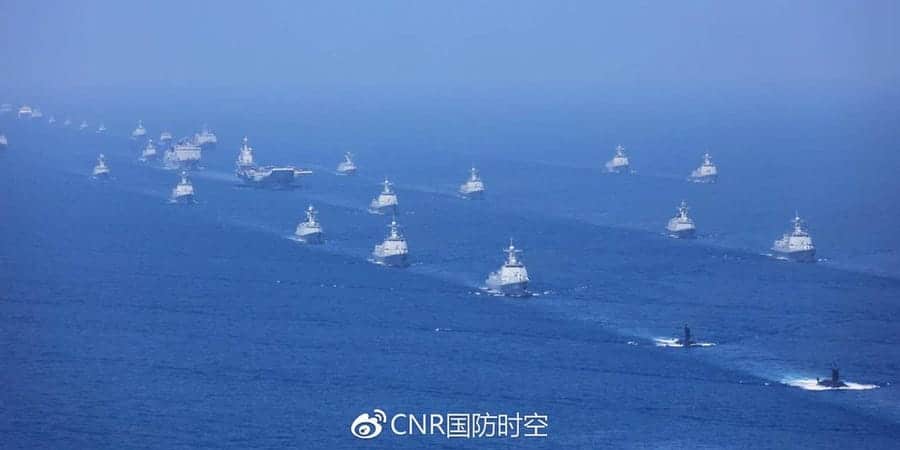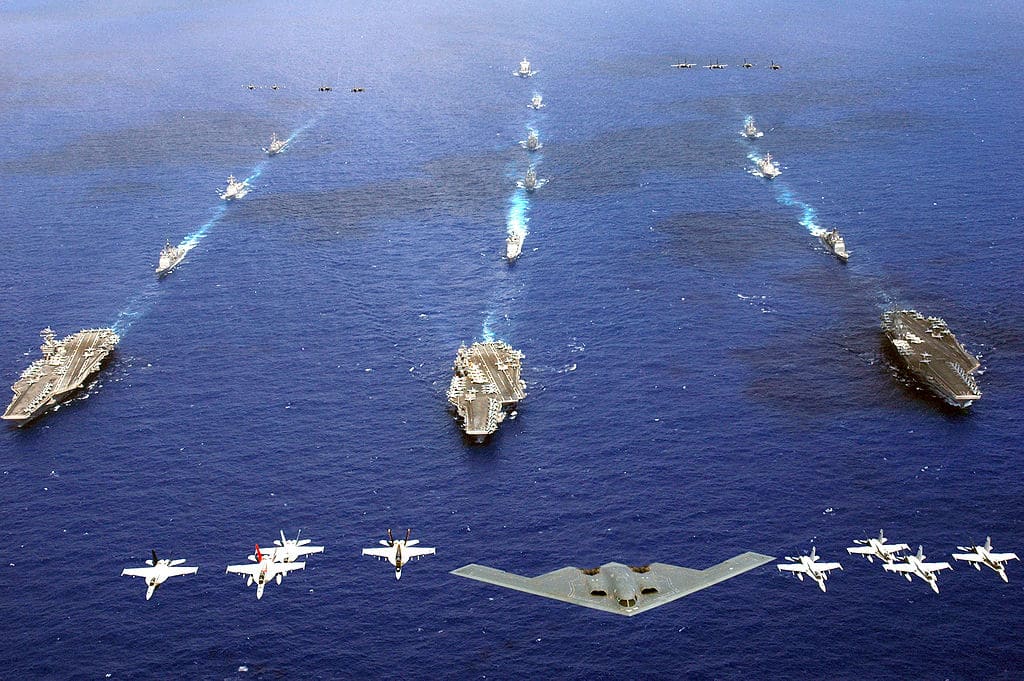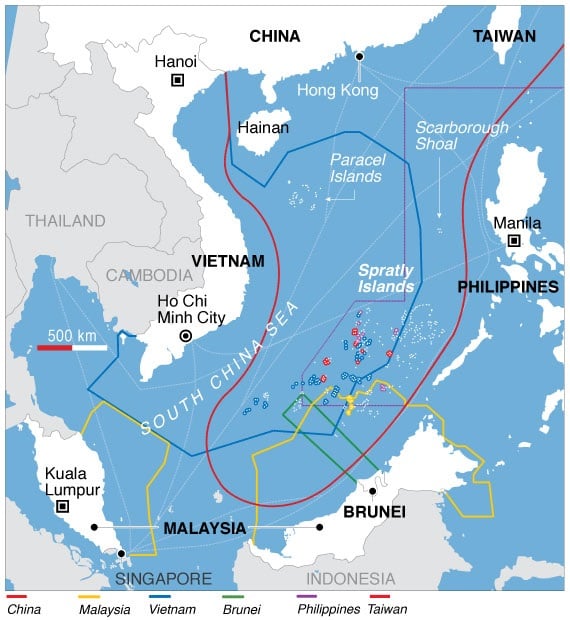American Pirates? US privateers could help win a war with China
- By Alex Hollings
Share This Article

After nearly two decades of counter-terror operations the world over, the United States military is now shifting its focus back toward great power competition with the likes of China and Russia. Unfortunately, as is so often the case, the past two decades have left the U.S. military particularly well suited for the Global War on Terror, but not very well positioned for the wars that are feasibly to come.
During this era of counter-terror operations, China has had the opportunity to seek higher degrees of technological and tactical parity, while having the benefit of not being actively engaged in expensive combat operations on the same scale. That has allowed China’s sea-faring power to grow at an exponential rate in recent years, with an active fleet of more than 770 vessels sailing under the banners of the People’s Liberation Army-Navy, their militarized Coast Guard, and a maritime miitia that takes its orders from the Chinese military as well.

Related: SEALs going ‘back to the future’ in shift to near-peer warfare
The addition of China’s massive ballistic missile stockpile, including hypersonic anti-ship platforms the U.S. Navy currently has no means to defend against, has further established China’s advantage in the Pacific. Even if the U.S. Navy leveraged every vessel in its 293-ship fleet, American forces would still be outnumbered by Chinese ships by more than two to one. Importantly, however, the United States likely couldn’t devote its entire fleet to any single conflict due to its global commitments to security and stability, especially regarding essential shipping lanes.
Today, the U.S. Navy and Marine Corps are both actively seeking ways to mitigate China’s numbers advantage, as well as the area-denial bubble created by China’s anti-ship platforms. Multiple possible solutions are being explored, ranging from hot-loading Marine Corps F-35Bs on austere airstrips on captured islands in the case of the Marines, to the Navy’s ongoing development of the MQ-25 aerial refueling drone that aims to extend the reach of America’s carrier-based fighters. Still, thus far, there has been no magic bullet. In fact, concerns about a near-peer conflict with China has even prompted several high-ranking defense officials to question the practicality of America’s fleet of super-carriers, both because of their immense cost, and because of the likelihood that they could be sunk by China’s hypersonic missiles long before they could get close enough to Chinese shores to begin launching sorties of F-35Cs and F/A-18 Super Hornets.

Related: China’s aircraft carrier fleet is growing faster than expected
The fundamental challenges a war with China would present are clear: Finding a way to mitigate the risks posed by advanced anti-ship missiles and offsetting the significant numbers advantage Chinese forces would have within the region. In the past, we’ve discussed the possibility of arming commercial cargo ships with modular weapons systems in a “missile barge” fleet as a means to bolster American numbers and capabilities. Another feasible option that could even work in conjunction with this strategy would be issuing “letters of marque” to private operations, effectively allowing non-military forces to serve as privateers for the U.S. government.
American Privateers or Pirates?

The concept of issuing letters of marque to American privateers was recently discussed by retired Marine Colonel Mark Cancian and Brandon Schwartz in the U.S. Naval Institute’s publication, “Proceedings.” Although the idea seems almost ridiculous in the 21st Century, the legal framework outlined by Cancian and Schwartz is sound, and one could argue that their assertions about the viability and strategic value of privateer fleets are as well.
Cancian and Schwartz argue that privateering is not piracy, as there are laws governing it and precedent for the practice established in past U.S. conflicts, including the American Revolutionary War and the War of 1812.
“Privateering is not piracy—there are rules and commissions, called letters of marque, that governments issue to civilians, allowing them to capture or destroy enemy ships. The U.S. Constitution expressly grants Congress the power to issue them (Article I, section 8, clause 11).”
-“Unleash the Privateers!” In Proceedings
However, despite their argument being technically right, it’s difficult to dismiss how the piracy narrative would almost certainly affect public perception of the use of privateers, and potentially even the conflict at large.
While the United States could argue that privateers operate with specifically outlined rules and commissions, even the American public would likely see American privateers as pirates. And because America has found itself trailing behind nations like China and Russia in terms of manipulating public narratives, that narrative could indeed hurt not only public support for the conflict; it could even jeopardize some international relationships.

Privateers are not pirates in the literal sense only because a government is sanctioning their piracy. In the eyes of those who don’t recognize America’s authority to grant such permissions in far-flung waterways, the two terms would be interchangeable.
Regardless of vernacular, the United States has used this approach to great success in the past. Although the last time American privateers set sale was more than 200 years ago, their approach was modern enough to set precedent for a return to the concept.
“The privateering business was thoroughly modern and capitalistic, with ownership consortiums to split investment costs and profits or losses, and a group contract to incentivize the crew, who were paid only if their ship made profits. A sophisticated set of laws ensured that the capture was ‘good prize,’ and not fraud or robbery. After the courts determined that a merchant ship was a legitimate capture, auctioneers sold off her cargo of coffee, rum, wine, food, hardware, china, or similar consumer goods, which ultimately were bought and consumed by Americans.”
-Frederick C. Leiner in “Yes, Privateers Mattered“
In the event of a large-scale conflict with a nation like China, that potential narrative blowback may be a necessary evil. However, the ramifications of that evil could be mitigated through a concerted narrative effort to frame privateer actions in the minds of the populous as an essential part of a broader war effort that has the American people’s best interests in mind.
In the War of 1812, privateering saw such public support (in large part thanks to the profits it drove) that some took to calling the conflict the “War of the People.” Managing the narrative surrounding American privateers could make the concept far more palatable to the American people.
As for the legal aspects of privateering, you can read a thorough legal justification for the practice in a separate piece written by Schwartz called “U.S. Privateering is legal.”
The role of American privateers at war

China’s massive fleet of vessels in the Pacific can be broken down into their three command groups, all of which ultimately answer to China’s People’s Liberation Army. China’s maritime militia accounts for approximately 300 vessels, the militarized Coast Guard has 135 more, and the PLA-Navy itself boasts an ever-growing roster expected to reach 450 surface vessels by the end of the decade.
In the event of a war with China, the American Navy would have more than its hands full engaging with such a massive force, limiting its ability to cut China off from one of its most significant revenue sources, overseas trade. China’s reliance on shipping products to other nations has helped its economy grow rapidly, but it also represents a strategic disadvantage, as Cancian and Schwartz point out, if America can find the means to disrupt this exchange.
“Thirty-eight percent of its gross domestic product (GDP) comes from trade, against only 9 percent of U.S. GDP. Chinese social stability is built on a trade-off: The Chinese Communist Party has told the people they will not have democratic institutions, but they will receive economic prosperity.”
-“Unleash the Privateers!” In Proceedings
In 2018, China’s merchant fleet was already approaching 2,200 total vessels, thanks to massive external demand for inexpensive Chinese exports. America’s Navy would likely be stretched too thin to actually blockade such an expansive merchant fleet. Like with aircraft, America’s preference for large and expensive ships that are capable of fulfilling multiple roles has offered increased capability but significantly decreased numbers. At its peak during World War II, the U.S. Navy boasted more than 6,000 ships. Today, the Navy has 293 far more capable vessels, but none can be in more than one place at a time.

American Arleigh Burke-class guided-missile destroyers, for instance, are too big and expensive to task with waiting out Chinese ships hiding in foreign ports, and would likely largely be assigned to Aegis missile defense operations. This is where American privateers could offer an important service.
American privateers wouldn’t be tasked with engaging the Chinese Navy or even with sinking merchant ships. Instead, they would be tasked with capturing Chinese cargo vessels, offering them a multi-million dollar bounty on each, and quickly compromising China’s ability to sustain its export sales.
“Since the goal is to capture the hulls and cargo, privateers do not want to sink the vessel, just convince the crew to surrender. How many merchant crews would be inclined to fight rather than surrender and spend the war in comfortable internment?”
-“Unleash the Privateers!” In Proceedings
Of course, despite Cancian and Schwartz’ dismissive take on how apt Chinese crews would be to fight to maintain control of their ships, it’s important to remember that these privateers would likely be engaging in close-quarters fighting with Chinese crews or security on board. As American privateers proved more costly to the Chinese government, an increased emphasis on protecting these cargo ships would almost certainly follow.
This begs an essential question: Where do you find privateer crews?
Private infrastructure already exists

While the concept of American privateers seems borderline fantastical, the truth is, the United States has already leveraged the premise of using non-military personnel for security and defensive operations the world over. American security firm Blackwater (now Academi) is perhaps the highest-profile example of America’s use of private military contractors. In fact, contractors in Iraq have reached numbers as high as 160,000 at some points, nearly equaling the total number of U.S. military personnel in the region. At least 20,000 of those private contractors filled armed security roles.
So while the term “privateer” or even pirate suggests an entirely unconventional approach to modern warfare, the premise is already in play. Terminology may dictate perception to a significant degree, but in practice, privateering wouldn’t be all that different from existing relationships the United States maintains with private security outfits. Further, private security firms, including Blackwater, have already operated at sea in a similar manner to privateers, from Blackwater’s armed patrol craft policing Somali pirates off the Horn of Africa to countless armed and privately owned boats patrolling the Indian Ocean today.

Many such organizations, with existing infrastructure and established relationships with the U.S. government, would likely seek and win contracts, or letters of marque, in the early days of a burgeoning Sino-American war, and stand up their own forces far more quickly than the United States could expand its naval force in the same volume. Rather than building ships and enlisting crews, the United States could simply authorize existing ships with existing crews to go on the offensive against China’s commercial fleets.
The American government’s experience with military contractors throughout the War on Terror means these relationships would not be as without precedent as they may seem, and the existing private military industry would make American privateers a quick and effective means to grow America’s offensive capabilities.
A complicated solution to a complex problem

Of course, there are many variables at play when discussing a future conflict with China. Incorporating privateers into such a strategy admittedly seems rather extreme from our vantage point in 2020, but it’s important to note that there is no precedent for what something like a 21st Century Sino-American war might look like. The massive sea battles of World War II may offer some sense of scale, but the rapid advancement of technology in the intervening decades creates a hypothetical war that is simply incongruous with the World War II models.
America does boast the largest and most powerful military in the world, but China’s rapidly expanding and modernizing force has not been growing in a vacuum. From space operations to warship construction, China has been developing its war-fighting apparatus with America specifically in mind. China isn’t interested in competing with the United States on its terms and instead has been focused on identifying potential American vulnerabilities and tailoring new capabilities to leverage those flaws.

Large scale warfare between technological and economic giants would play out differently than any conflict we’ve ever seen. In order to emerge from such a conflict successfully, America has to do much more than win. Once the price of victory begins to compromise America’s ability to sustain its way of life thereafter, that victory becomes less pronounced.
In order to win in such a conflict, the United States will need to dig deep into its bag of tricks. On the home front, it would mean finding ways to rapidly expand America’s industrial base to replenish vehicles, supplies, and equipment as they’re expended or destroyed on the front lines. The U.S. Navy, Marine Corps, Army, Air Force, and Space Force will all be required to communicate and rely on one another in ways never before accomplished on a battlefield.
And China’s massive numbers advantage would have to be mitigated somehow. American privateers, or pirates as the press would surely call them, might just do the trick.
Read more from Sandboxx News:
- Army increasing awareness of maritime domain in Indo-Pacific
- M-SHORAD system bolsters Army’s air defense capabilities
- Army analyzing needs for Arctic operations
- CSAF emphasizes safe, secure, reliable nuclear deterrence
- Army, Navy SATCOM mission areas shifting to Space Force
This article was originally published 10/21/2020
Related Posts
Sandboxx News Merch
-

‘Sandboxx News’ Dad Hat
$27.00 Select options This product has multiple variants. The options may be chosen on the product page -

‘AirPower’ Golf Rope Hat
$31.00 Select options This product has multiple variants. The options may be chosen on the product page -

F-35 ‘Lightning’ Framed Poster
$45.00 – $111.00 Select options This product has multiple variants. The options may be chosen on the product page

Alex Hollings
Alex Hollings is a writer, dad, and Marine veteran.
Related to: Military Affairs

A Green Beret remembers his favorite foreign weapons

The AGM-181 LRSO missile will modernize America’s nuclear triad

Navy will soon announce the contract award for its F/A-XX 6th-generation jet, according to reports

America’s new air-to-air missile is a drone’s worst nightmare
Sandboxx News
-

‘Sandboxx News’ Trucker Cap
$27.00 Select options This product has multiple variants. The options may be chosen on the product page -

‘AirPower’ Classic Hoodie
$46.00 – $48.00 Select options This product has multiple variants. The options may be chosen on the product page -

‘AirPower’ Golf Rope Hat
$31.00 Select options This product has multiple variants. The options may be chosen on the product page -

‘Sandboxx News’ Dad Hat
$27.00 Select options This product has multiple variants. The options may be chosen on the product page
